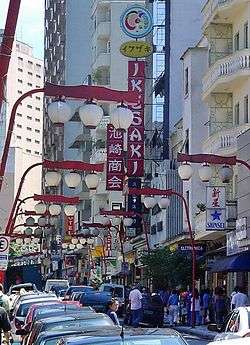Japanese community of São Paulo
The single largest Japanese diaspora in any city is in São Paulo.[1] In 1958 the census counted 120,000 Japanese in the city and by 1987, there were 326,000 with another 170,000 in the surrounding areas within São Paulo state.[2] As of 2007, the Paulistano Japanese population outnumbered their fellow diaspora in the entirety of Peru, and in all individual American cities.[2]
History
The Japanese first settled Liberdade in 1912.[3]
Commerce
The Câmara de Comércio e Indústria Japonesa do Brasil (ブラジル日本商工会議所 Burajiru Nihon Shōkōkaigisho), the ethnic Japanese chamber of commerce,[3] has its offices in Andar.[4] It opened in 1926.[3]
During World War II trade between Brazil and Japan had declined.[3]
Media
In São Paulo there are two Japanese publications, the São Paulo Shimbun and the Nikkey Shimbun, both published in the Liberdade district.[5] The former was established in 1946 and the latter was established in 1998. The latter has a Portuguese edition, the Jornal Nippak, and both publications have Portuguese websites. The Jornal Paulista, established in 1947, and the Diário Nippak, established in 1949, are the predecessors of the Nikkey Shimbun.[6]
Tatiane Matheus of O Estado de S. Paulo stated that in the pre-World War II period the Nippak Shimbun, established in 1916; the Burajiru Jiho, established in 1917; and two newspapers established in 1932, the Nippon Shimbun and the Seishu Shino, were the most influential Japanese newspapers. All were published in São Paulo.[6]
Education
The city has one Japanese international day school, the Escola Japonesa de São Paulo ("São Paulo Japanese School"), located in Vila Prel, Capão Redondo, Subprefecture of Campo Limpo.[7] The school opened on August 14, 1967.[8]
As of 2003, around 33% of the Japanese supplementary schools in southern Brazil are in the city of São Paulo. As of 2003 almost all of the directors of the São Paulo schools were women.[9]
History of education
The Taisho School, Brazil's first Japanese language school, opened in 1915 in São Paulo.[10] In the 1980s, São Paulo Japanese supplementary schools were larger than those in other communities. In 1992 the São Paulo Metropolitan Area had 95 Japanese schools, and the schools in the city limits of São Paulo had 6,916 students.[9]
Hiromi Shibata, a PhD student at the University of São Paulo, wrote the dissertation "As escolas japonesas paulistas (1915-1945)", published in 1997. Jeff Lesser, author of Negotiating National Identity: Immigrants, Minorities, and the Struggle for Ethnicity in Brazil, wrote that she "suggests" that the Japanese schools in São Paulo "were as much an affirmation of Nipo-Brazilian identity as they were of Japanese nationalism."[11]
Recreation and culture
The Museu Histórico da Imigração Japonesa no Brasil (ブラジル日本移民史料館 Burajiru Nihon Imin Shiryōkan) is located in Liberdade.[12] Exhibits on Japanese Brazilian culture occupy two floors of the museum.[3]
The Pavilhão Japonês, an exact replica of the Katsura Imperial Palace, is located in the Ibirapuera Park. Built in Japan, this pavilion was presented as part of São Paulo's 400th anniversary celebrations.[3]
The Instituto Tomie Ohtake, a cultural institute occupying two floors of a building, opened in November 2001. It was one of several buildings in São Paulo designed by Ruy Ohtake, the son of Tomie Ohtake.[3]
Every April the Hanamatsuri is held. Every July the Tanabata Matsuri is held. Japanese festivals take place around the Liberdade area.[3]
Notable residents
- Ruy Ohtake (architect) - Anna Fitzpatrick, a contributing reporter of The Rio Times, wrote that Ruy Ohtake's architecture, including the institute and the hotel Hotel Unique, give "a look of modern Japanese style to the city."[3]
See also
References
- Lesser, Duke. A Discontented Diaspora: Japanese Brazilians and the Meanings of Ethnic Militancy, 1960–1980. Duke University Press, September 14, 2007. ISBN 082234081X, 9780822340812.
Notes
- ↑ Geromel, Ricardo. "All You Need To Know About Sao Paulo, Brazil's Largest City." Forbes. July 12, 2013. Retrieved on March 20, 2014.
- 1 2 Lesser, A Discontented Diaspora: Japanese Brazilians and the Meanings of Ethnic Militancy, 1960–1980, p. 3.
- 1 2 3 4 5 6 7 8 9 Fitzpatrick, Anna (Contributor Reporter). "Japanese Culture and Architecture in São Paulo." The Rio Times. November 8, 2011. Retrieved on March 19, 2014.
- ↑ "Home." Câmara de Comércio e Indústria Japonesa do Brasil. Retrieved on March 19, 2014. "Av. Paulista, 475 - 13º Andar - São Paulo - SP - Brasil - Cep 01311-908"
- ↑ "Contato." São Paulo Shimbun. Retrieved on March 17, 2014. "Jornal São Paulo Shimbun - Rua Mituto Mizumoto, 255 - Liberdade - São Paulo - SP"
- 1 2 Matheus, Tatiane. "O outro lado da notícia." O Estado de S. Paulo. 9 February 2008. Retrieved on 17 March 2014. "O primeiro jornal japonês no País foi o Nambei,[...]"
- ↑ Home page. Escola Japonesa de São Paulo. Retrieved on March 18, 2014. "Estrada do Campo Limpo,1501 ,São Paulo-SP"
- ↑ "学校紹介." Escola Japonesa de São Paulo. Retrieved on March 18, 2014.
- 1 2 Carvalho, Daniela de. Migrants and Identity in Japan and Brazil: The Nikkeijin. Routledge, August 27, 2003. ISBN 1135787654, 9781135787653. Page number unstated (Google Books PT46).
- ↑ Goto, Junichi (Kyoto University). Latin Americans of Japanese Origin (Nikkeijin) Working in Japan: A Survey. World Bank Publications, 2007. p. 7-8.
- ↑ Lesser, Jeff. Negotiating National Identity: Immigrants, Minorities, and the Struggle for Ethnicity in Brazil. Duke University Press, 1999. ISBN 0822322927, 9780822322924. p. 231.
- ↑ "Home." Museu Histórico da Imigração Japonesa no Brasil. Retrieved on March 19, 2014. "Rua: Joaquim, 381 - Liberdade - Cep: 01508-900 - São Paulo - SP"
Further reading
- Shibata, Hiromi. "As escolas Japonesas paulistas (1915-1945)" (Ph.D. dissertation, University of Sao Paulo, 1997).
External links
- BUNKYO Sociedade Brasileira de Cultura Japonesa e de Assistência Social (Portuguese) (ブラジル日本文化福祉協会)
- ACBJ Aliança Cultural Brasil, Japão (Portuguese)
